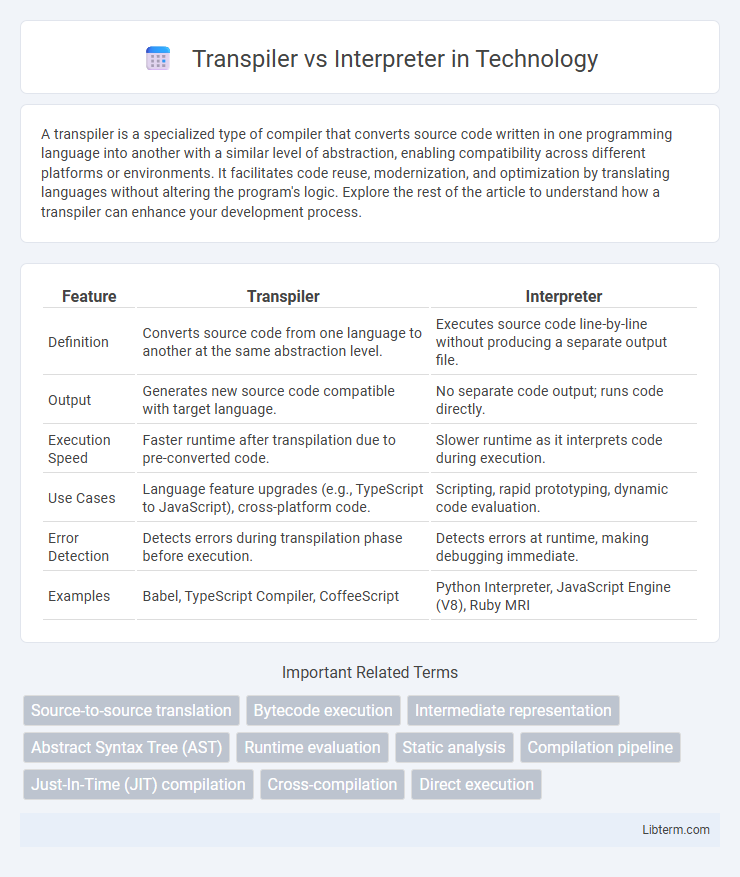A transpiler is a specialized type of compiler that converts source code written in one programming language into another with a similar level of abstraction, enabling compatibility across different platforms or environments. It facilitates code reuse, modernization, and optimization by translating languages without altering the program's logic. Explore the rest of the article to understand how a transpiler can enhance your development process.
Table of Comparison
| Feature | Transpiler | Interpreter |
|---|---|---|
| Definition | Converts source code from one language to another at the same abstraction level. | Executes source code line-by-line without producing a separate output file. |
| Output | Generates new source code compatible with target language. | No separate code output; runs code directly. |
| Execution Speed | Faster runtime after transpilation due to pre-converted code. | Slower runtime as it interprets code during execution. |
| Use Cases | Language feature upgrades (e.g., TypeScript to JavaScript), cross-platform code. | Scripting, rapid prototyping, dynamic code evaluation. |
| Error Detection | Detects errors during transpilation phase before execution. | Detects errors at runtime, making debugging immediate. |
| Examples | Babel, TypeScript Compiler, CoffeeScript | Python Interpreter, JavaScript Engine (V8), Ruby MRI |
Introduction to Transpilers and Interpreters
Transpilers convert source code from one programming language to another at a similar abstraction level, preserving program semantics while optimizing compatibility across platforms. Interpreters execute code directly by translating each high-level instruction into machine actions dynamically at runtime, offering flexibility in debugging and immediate feedback. Understanding their distinct mechanisms enhances decisions on choosing appropriate tools for development, performance, and deployment scenarios.
Definition of a Transpiler
A transpiler, also known as a source-to-source compiler, converts source code written in one programming language into another language with a similar level of abstraction, enabling cross-language compatibility and development. Unlike interpreters that execute code directly, transpilers produce equivalent code that can be compiled or run later, often used to translate modern JavaScript (ES6+) into older versions for browser support. Key examples include Babel for JavaScript and TypeScript compilers, enhancing code portability and maintainability across different environments.
Definition of an Interpreter
An interpreter is a type of computer program that directly executes instructions written in a programming or scripting language without requiring them to be previously compiled into machine code. It processes the source code line-by-line or statement-by-statement, translating and running each command on the fly. Unlike transpilers, interpreters do not produce an intermediate language but enable quicker testing and debugging during software development.
Key Differences Between Transpilers and Interpreters
Transpilers convert source code from one high-level programming language to another, preserving the original code's structure, while interpreters execute code directly by translating it line-by-line at runtime. Transpilers typically generate output code that can be further compiled or executed independently, whereas interpreters rely on runtime execution without producing an intermediate code file. Performance-wise, transpiled code often runs faster since it is pre-converted, whereas interpreted code experiences runtime overhead due to on-the-fly translation.
How Transpilers Work: Step-by-Step Process
Transpilers work by first parsing the source code into an Abstract Syntax Tree (AST), representing the program's structure. The AST undergoes transformations to convert language-specific syntax and semantics into the target language's equivalent constructs. Finally, the transformed AST is serialized back into readable source code in the target language, enabling seamless code migration or compatibility across different programming environments.
How Interpreters Work: Step-by-Step Process
Interpreters execute code by reading source code line-by-line and converting each statement into machine-executable instructions during runtime. The process begins with lexical analysis, where the interpreter breaks down the code into tokens, followed by syntax analysis to build an abstract syntax tree (AST). Finally, the interpreter evaluates the AST nodes sequentially, performing operations and managing runtime environments to produce immediate output.
Advantages of Using a Transpiler
Transpilers convert source code from one programming language to another, enabling developers to leverage advanced features of modern languages while maintaining compatibility with older platforms or browsers. This process enhances code optimization and improves runtime efficiency by generating cleaner, more performant target code compared to interpreters. Transpilers also facilitate cross-platform development, allowing seamless integration and improved maintainability without sacrificing functionality or development speed.
Advantages of Using an Interpreter
An interpreter executes code line-by-line, enabling immediate error detection and simplifying debugging during development. It supports dynamic typing and runtime flexibility, allowing developers to test code changes quickly without the need for recompilation. Interpreters enhance platform independence by running source code directly on any system with the appropriate runtime environment.
Real-World Examples: Transpiler vs Interpreter
Babel is a widely used transpiler that converts modern JavaScript (ES6+) into backward-compatible versions for older browsers, enabling web developers to use new language features without compatibility concerns. In contrast, the Python interpreter executes code line-by-line at runtime, allowing dynamic typing and immediate feedback, which is essential for rapid development and debugging. TypeScript's compiler acts as a transpiler translating TypeScript into JavaScript, while JavaScript engines like V8 function as interpreters or just-in-time compilers to run the JavaScript code efficiently in browsers.
Choosing the Right Tool: Use Cases and Recommendations
Transpilers excel in scenarios requiring code transformation between languages, especially when targeting different runtime environments or improving performance without altering logic, making them ideal for cross-platform development and legacy code modernization. Interpreters suit dynamic code execution, rapid prototyping, and debugging due to their ability to execute code line-by-line, preferred in educational settings and scripting tasks where flexibility and immediate feedback are critical. Choosing between a transpiler and an interpreter depends on factors like execution speed, language compatibility, and development workflow, with transpilers favored for production-level optimization and interpreters for development agility and ease of error detection.
Transpiler Infographic

 libterm.com
libterm.com